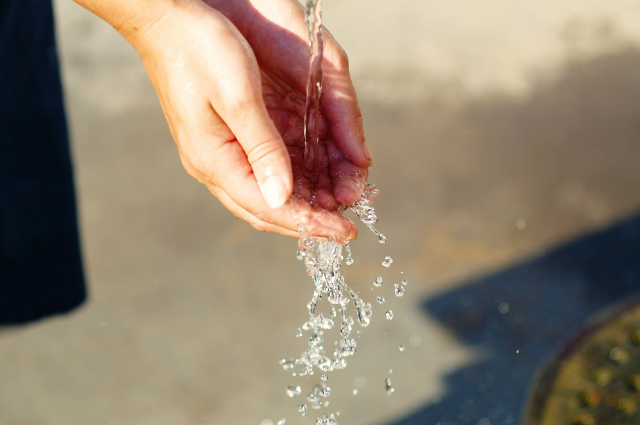
Image by Tibor Janosi Mozes from Pixabay
Water is agreed to be the life of the living. It is said that every living substance needs water every moment. Any living cannot live without water. The feeling of thirst is nothing but the expression of the human body of a deficit of fluid portion in the body. Nature, with its kindness, provides an abundant quantity of water around living organisms in different forms. Rain is a natural phenomenon that makes the earth wet and fertile to produce food for humans as well as for animals, birds, etc. The water gifted by nature in the form of rain is stored in the low areas, like ponds, rivers, lakes, etc. which are used by the needy living directly for external cleaning purposes like washing clothes, utensils, bathing, etc., and for internal use like drinking, food preparation, etc.
Considering the need and utility of water for the continuation of life our ancestors describe it with honor and respect. They studied the detail of the sources, qualities, uses, utilities, etc. of water very sincerely and described it in detail. Some examples of such description and discussion are mentioned as an example -
- Rain is the main source of water. It is considered to be the gift of Lord Indra and hence rainwater is synonymized as “Aindrajala” and it is said that the water collected directly from rain is the best for use. When it falls on the earth it becomes lodged in the natural reservoirs and acquires the soil quality.
- The water collected in the pond, river, lake, etc. naturally takes the quality of the soil and shows the effect of Kafabardhaka (increases heaviness, indigestion, etc., and causes edema, anorexia, etc. ), Pittabardhaka (causes a burning sensation, the yellowish coloration of the body, excreta, etc.), Vatabardhaka (causes emaciation, dryness, neurological disorder, etc.).
- The worst and most rejectable water in nature is said to be the river water of the rainy season (BARSHANADEYAJALA) as it washes the dirt of the surrounding area. This water causes a good number of diseases.
- The water available in the natural sources becomes purified by the natural effect of the star “AGASTYA” and becomes usable directly from its natural source. “AGASTYA” is said to be the star with detoxification (BISHAGHNA) effect. The season of increase in the effect of AGASTYA on the earth is said to be during the autumn season.
- Water is advised to use by a person with justification in adequate quantity at the appropriate time. It is said that if one drinks water at the beginning of food then it reduces the quantity of food taken and makes the person thin (Krisha) whereas taking water after food makes the person obese. Drinking water in small quantities during food is said to be a healthy practice.
- Boiled water (KWATHITA JALA) is said to be the best water for drinking in all seasons for all persons. Qualities and utilities of the boiled water concerning the residue (half, fourth, one-third, etc. ) are also described clearly in the ancient classics, especially in the Ayurvedic classics.
- Pollution of water with special reference to character, harm can be caused and purification methods are discussed elaborately. Purification of water by using the ash of some selected plant parts, some valuable gems, etc. is also interesting information available in the classics.
- For identification of polluted water (DUSHITA JALA ) examination with the sense organs, like an inspection for color, clarity, etc., touch for any irritation caused when touched like itching, burning, redness, eruption, etc., taking of smell for any specific/foul smelling, etc. taste for any irritation of the tongue, oral cavity, etc. are advised. A list of the signs and symptoms that can be caused due to exposure to polluted water is also mentioned in the classics.
- Causing poisoning of water used by the enemy during wartime is also described vividly, especially in the Ayurvedic classics. The signs and symptoms of using such water are described not only concerning human beings but also with the animals like elephants, horses, etc. It is said that the animals show some very markable and interesting signs when it comes to contact with such water.
- Coming into touch with polluted (poisoned – bhakta) water one may become the victim of chronic and “difficult to treat” skin diseases with itching (kandu), redness (raga), dirtiness (kinda), roughness (karate), etc. The treatment for such a condition is also advised.
- The water that flows from a high altitude with a strong current through a stony area is said to be the best one for use as it becomes purified by the strong friction with the stones. Hence the water of the rivers originating from the Himalayas is said to be the best.
- The use of Tulsi leaf (holy basil) by the priests to purify water to be used for rituals with chanting of prescribed verses (MANTRA) is also an interesting fact.
- Description of the character of the water of different rivers like flowing from the northern hills, southern hills, etc. is also interesting. In the Indian culture, purifying water for use in the religious rituals inviting the rivers Ganga, Yamuna, Godavari, and Saraswati needs further study and research.
HENCE STUDY AND RESEARCH ON THE INDIAN CLASSICAL CONCEPTS, ESPECIALLY THE AYURVEDIC CLASSICS CAN BE CONSIDERED TO HAVE THE UTMOST INTEREST AND IMPORTANCE.
